

You may have noticed late last year the AANA broadened their official definition of “advertising” beyond that of a paid-for message. To reflect the changes the Internet has brought about, they now refer to “marketing communication” activity as brands are now often engaging in two-way conversations, not just pushing messages one-way via ads.
Early this year CommBank’s CMO Andy Lark, an ex PR man himself, told PR agencies they risked losing their traditional area of expertise to digital experts and integrated agencies.
The issue for businesses isn't simply which external supplier or internal staff is running your social media. With new technology comes a lack of control over how customers choose to seek information and engage with you, which brings a new level potential for confusion. And just as there is confusion around whom within a company or it’s preferred communications partners should be in charge of the conversation, the laws we all operate under right now are equally confused.
Who is responsible for comments posted on your business Facebook page?
In response to an ACCC ruling and fine of a liquor brand for leaving comments on it’s Facebook page deemed to he inappropriate, the AANA extended the reach of its Codes to cover most forms of advertising and marketing communication over which the advertiser or marketer has a reasonable degree of control.
In two recent determinations dealing with brand-owned Facebook pages, the Advertising Standards Board (ASB) reflected the AANA’s intent and stated:
“The Board considered that the Facebook site of an advertiser is a marketing communication tool over which the advertiser has a reasonable degree of control and that the site could be considered to draw the attention of a segment of the public to a product in a manner calculated to promote or oppose directly or indirectly that product."
"As a Facebook page can be used to engage with customers, the Board further considered that the Code applies to the content generated by the page creator as well as material or comments posted by users or friends.”
While you may think this ruling is a bit rough, at least you know where you stand. Until this week.
The AANA at least gave clarity, we now have a contradictory new set of guideline by the IAB
“After a careful analysis of existing laws and regulation and industry practice around social media IAB Australia has reached the view that user comments directed towards an organisation or social media platform, or to other users who are drawn to a particular organisation, do not constitute advertising,”
According to Samantha Yorke, director of regulatory affairs at IAB, “There is a real risk that organisations who treat user comments as advertising will err on the side of caution and moderate user comments very conservatively, which will adversely impact their presence on social platforms and which arguably undermines the very spirit under which social media thrives,”
I wonder what a judge will say about a marketer’s immoderate management of a social media campiagn in a yet to be held ACCC hearing?
UNO is one of a small number of marketing communications agencies accredited by The Communications Council of Australia. We believe self regulation only works when all of our customers' messages within our control are held to the same highest standards of paid-for and signed-off ads, irrespective of whether published in a traditional, new or yet to be invented medium. At least that way our clients have minimised their risks, both known and unknown.
Read More
There are many tips and how to guides claiming they have the key to revealing the relative strengths and weaknesses of where to advertise, promote and connect. Media sales reps have a long history of presenting charts and graphs that show their medium in a favourable light. To ensure the best ROI marketing, we only rely on those studies that have rigorous methods and meaningful numbers to make the findings reliable.
Don't trust every media benchmark you can Google
For those who want to know what medium is most effective at acquiring new customers in the digital era, here is a chart we feel is valid:
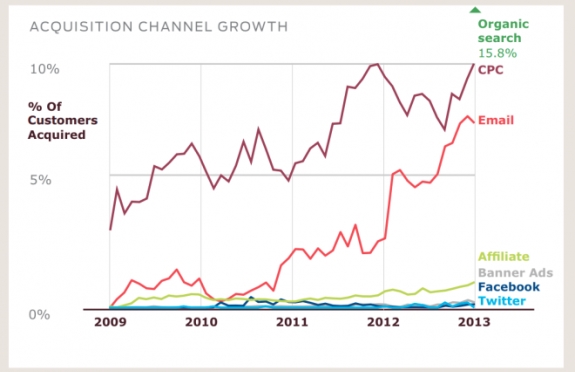
Trend in performance of digital channels for acquiring new customers
Custora came up with these figures by analysing data from 72 million customers shopping on 86 different retailer sites. They tracked where customers were clicking from (email, Twitter, Google, etc.) and what and how much they bought, not just on that visit but for the next two years.
Over those two years, Custora found that customers who came to retailers from search were 50 percent more valuable than average. In other words, they were more likely to shop more and spend more. Email customers were nearly 11 percent more valuable than average. Customers who came through Facebook were just about average. Twitter customers, meanwhile, were 23 percent less valuable than the average during the two years following that first click.
I've written before that our reluctance to spend clients' money on banner ads is based on one amazing fact: you are more likely to win Lotto than click on a banner ad.
In comparison to these digital channels, research by the Direct Marketing Association shows you may still be best served with good old direct mail:
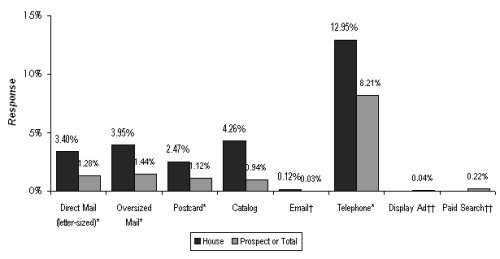
Average response rates for direct sales, DMA 2012
There is one new piece of research though that ultimately makes the discussions about differences between media effectiveness become a secondary consideration. It's proof of what many of us have always suspected.
How you craft your message is more important than the medium
The latest research into advertising effectiveness in Australia has proven creativity makes a big difference. The Association of Data-driven Marketing & Advertising shows that after 12 months ads with better ideas are both more effective and increase a brand's ability to harden pricing.
This reminds us you’re potentially wasting your time and money if you don’t get your pitch right. As consumers we remember big ideas, like “Think small.” Or the pulling power of a well crafted headline like “It’s Time.” Or a picture worth a thousand words...
The truth well told has been proven yet again to be more important in getting the best ROI from your marketing than any optimisation techniques digital specialists may dazzle the bean counters with. We are not animals, we are human, and we respond to emotions, not numbers of targeted exposures.
For those who want to make the most of their investment in airtime/space/or face-to-face, remember to invest a little in the art of communication.
It's not just consumer brands that can benefit from better communication
An ability to express your message is just as impotant for both service businesses and B2B. This is especially true for financial services, as shown by this chart of what customers say are the most important qualities in a financial adviser.
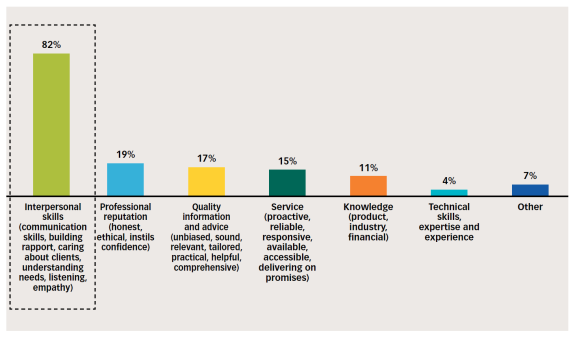
AFA White Paper: The Trusted Adviser May 2013
The report found the biggest difference in success of the top 10% of financial planners and the rest isn’t expertise, or credentials or technology – it’s the ability to communicate. Communication is not talking at people, it's the art of speaking with empathy. This is where social media excels. Use it to listen to your customers, then respond in a way that makes the individual believe you understand where they are coming from.
Irrespective of digital or traditional, face-to-face or in writing, where you have the conversation is secondary to the way you express yourself.
Just remember to make the message suit the medium. Our burping cow ring tone for Sipaah was downloaded by lots of kids who knew exactly where our brand was coming from.
Read MoreFame is the game of the name


The exponential pace of change is increasing the pressure on businesses to stay competitive. You know it’s not going to slow down. Fortunately there are still ways you can take control. One proven method is to revisit some simple building blocks to help make your brand relevant in today’s complex marketplace.
4 step process to make a challenger brand famous:
GAME
NAME
FAME
CLAIM
Game:
When did you last define what it is you do you do that makes you a specialist. In a cluttered business environment it pays to play in a defined niche where you know more about the rules of the game than your competition. Define the things that are of value to your prospect. Make sure you understand what it takes to be world’s best at your game, and work to stay at the top. People will still pay you a premium for something special that means something special to them.
With a fresh outside perspective, define your true differentiators, your “authentic truth.”
Name:
Your reputation, the brand and everything it does must be aligned with what you do that is special or your efforts will be diluted. Today, any business with integrity can compete against established incumbents. The cost of entry is no longer big budget mass media campaigns, the spoils now go to the nimble.
Today, the truth is what counts, the public can find the facts faster than businesses can attempt to shape opinion. Ensure your brand reflects your truth in everything you say and do.
Fame:
The art of being noticed. And remembered. And talked about.. You can do this several ways. Spend a lot of money, like Swisse, who invested up to 60% of annual revenue to marketing to achieve business growth, which stands at about 50% year-on-year over 4 years.
Or take the stand out in the crowd approach. An elevator pitch is only of value if people are listening, be too polite and you will be invisible. There is something to be said for the fart in a lift approach, however can you risk going viral with the wrong tone of voice?
Ideally, you can take the hero approach: be noticed by the right people for the right reasons. To do this ensure you choose the right medium for your message. There have never been so many communications options – a pitfall for the unwary, and an opportunity for the savvy
Claim:
Tell the truth, especially now the customer can search the Internet to discover what is a genuine claim and share with their friends what they find out. Decide what will differentiate you in your game – do you do it faster or smarter, cheaper or better?
Then find a creative way to express your difference. As J Walter Thompson said almost a century ago, “the truth well told” is the value add of great advertising.
Famous campaigns start with a defined customer benefit
What’s your “Which Bank?” How will you enter the vernacular, as this one of mine did 25 years ago:

With a creative leap, you can express the human insight that will resonate with your prospects. And they’ll repeat it to friends, again and again.
Read More

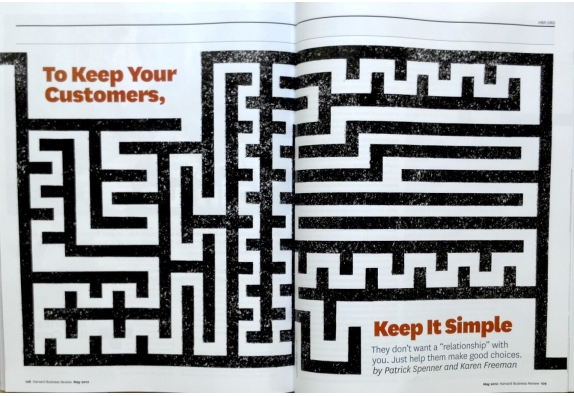
How do you explain to the manager who signs off your budget that today customers want more from your website than a brochure online? You can start by pointing out how you can replace existing fixed and recurrent costs with keener priced digital alternatives. Then remind the cost controller that technology is moving so fast they’ll be surprised how much more you can do today for less. A lot less than many of the savings to be made across existing business practices that digital can now enhance or replace. This 12 point digital checklist can help you keep it simple and the returns substantial.
Your digital project 12 point checklist
Keep an open mind, what the site needs to include is based on what the customer wants, don’t limit scope by prescribing whats to be included by your what your preconcievd ideas of what the competition have already done.
Engage with the user in the context of where and how they are accessing you. Are they on a mobile while in a shop, in bed on a tablet or at their workdesk on a PC? At work, at home, on the move, your site experience needs to change accordingly.
Educate or entertain? Ask yourself are they visiting your site to learn more, or simply because it is an enjoyable experience? Or would they like it if you did both? Deciding this helps shape your content and navigation.
Personalisation. "Allow users to personalise their experience. People love to add personal touches because it helps them feel at home and in control. Provide sensible, beautiful defaults, but also consider fun, optional customisations that don't hinder primary tasks." - Google Android
If you don't treat each customer as an individual, a competitor will. Technology now enables you to serve each visitor exactly what they want, a bespoke site just for them.
Innovate.The digitisation of everything now allows you to reinvent so many of your business functions and methods, take advantage of what is now possible.
Tone of voice is more important than what you say. The way the site looks, the colours used, typography, whether there are pictures or videos and the style of vocabulary you use will make a bigger impression about your brand image than what is in the text.
Services is what you build today, not websites. "Our service doesn’t begin and end at our website. It might start with a search engine and end at the post office. We need to design for that." - GOV.UK
Iterative, our most used word to describe our process for scoping, designing and building a digital service. Start small, constantly evolve and develop the service offer. We learn and improve the offer together as we go.
Marketing. A site without marketing is an island resort that’s not on any map, let alone an itinerary. Don’t launch and leave, have a plan that will drive customers and prospects to your site, align what the promise is and how your site will deliver to expectations.
P, there are 4 of them in marketing: Product, Price, Promotion, Place. Consider which of the Ps is most useful to enable you to best engage with each type of customer. The 4Ps of marketing aren’t all the same for every person or every occasion.
Load time is more important than looking good. Too many fancy things can slow down the experience.
"Make important things fast: Not all actions are equal. Decide what's most important in your app and make it easy to find and fast to use, like the shutter button in a camera, or the pause button in a music player." - Google Android
Effectiveness. Know what you want to achieve and why. Most importantly decide how you will measure with meaningful metrics that can be acted upon. Then you can build in measurement techniques to track what is working and what needs to be improved. And make sure someone is in charge of tracking results and implementing improvements.
If in doubt about what matters most, remember the customer's perspective comes first. Look at the first letter of our 12 points. In an increasingly complex world, when you connect with customers they will appreciate it of you can KEEP IT SIMPLE.
Read MoreRadioactive ads from when people didn't know better

Classic ads from 1910-1930 for radioactive products
What can’t radium cure? A century ago it was legal to advertise radioactive products, from toothpaste to suppositories, condoms and check out the chocolate!

If looks could kill: Radium lipstick advertisement from the 1930s. (via 109.com)
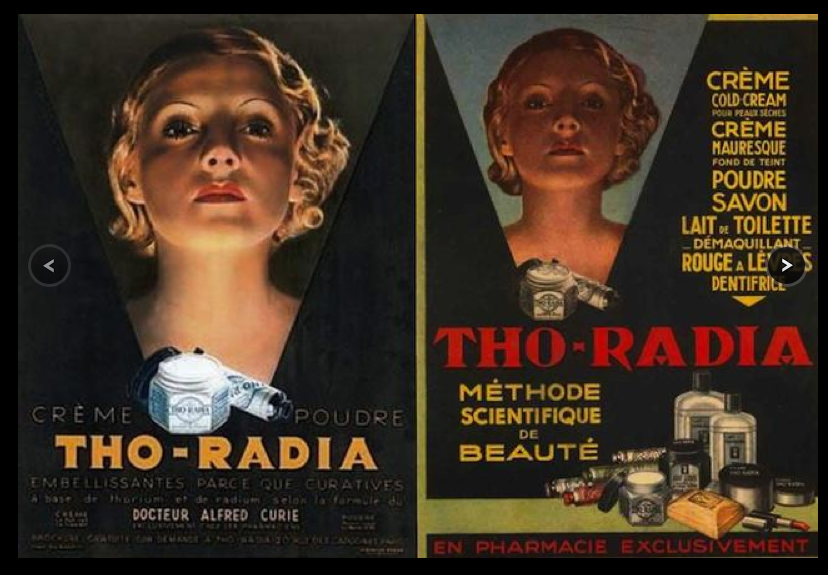
More classic ads from the 1930s for the Tho-Radia range of makeup.

Nil by mouth, guaranteed harmless?!! Gives new meaning to "the ring of confidence"

Anyhow, have a radium.
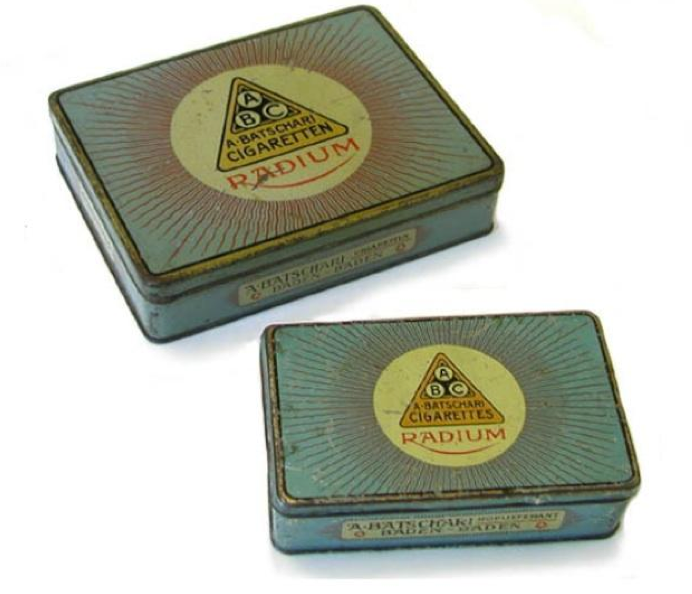
Now in a convenient pocket size pack of 20s. They didn't know smoking kills.

Mrs Marsh could give us a demonstration of the brighter effects on your smile of Radium toothpaste.

Chockaholics aren't left out, Radium is everywhere. The ads claimed eating a block would make you look younger.

Time wasn't on the side of those with radioactive numbered watches that glow in the dark.

Another ad campaign competing for share of the toothpaste that glows market, now with added thorium.
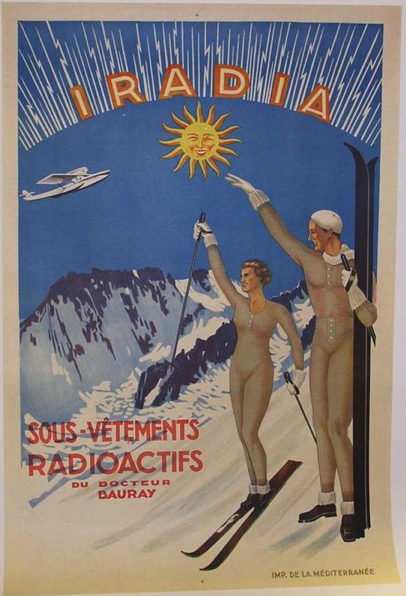
Radioactive wool keeps you warm on the slopes.
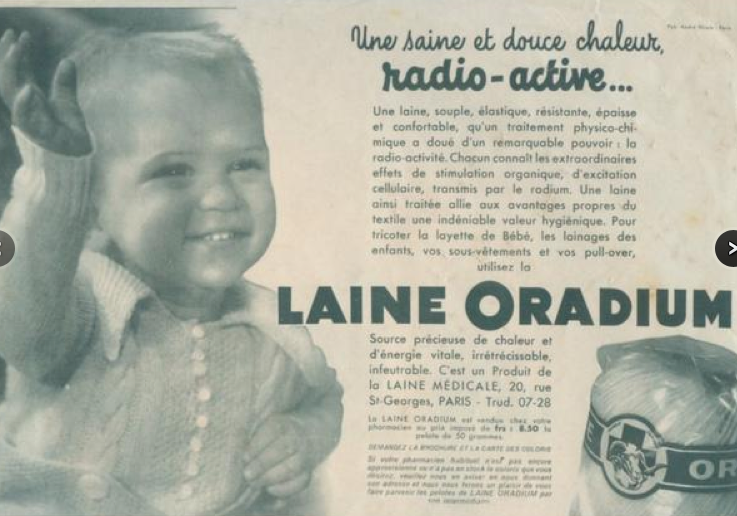
Dress your baby in it.

Advertised as a cure for arthritis, rheumatism, mental illnesses, stomach cancer and impotence. (via Real Food University and Oak Ridge Associated Universities) Triple distilled, who needs a whickey chaser?
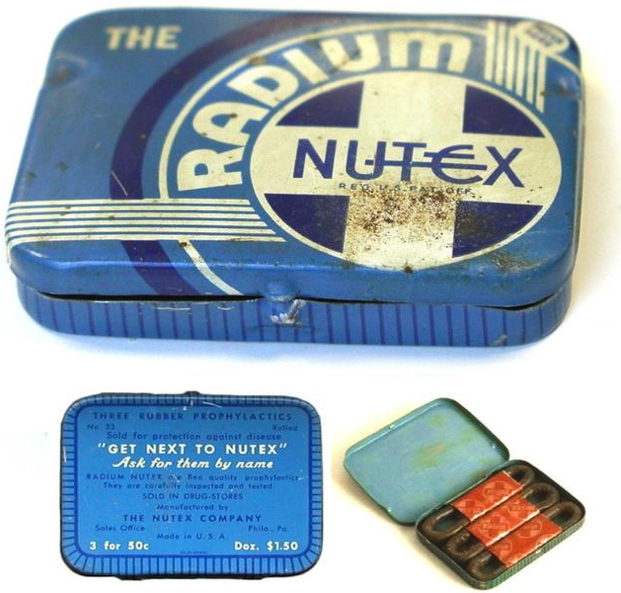
Condoms, that glow in the dark?
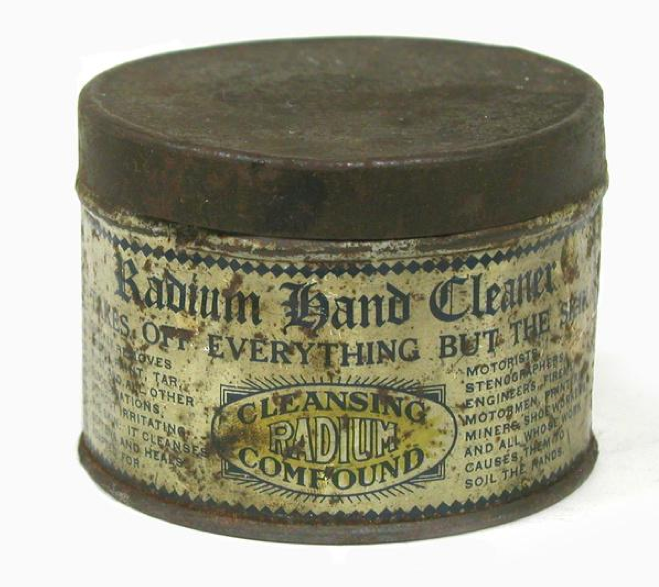
They didn't realise you can't wash off radiation poisoning.
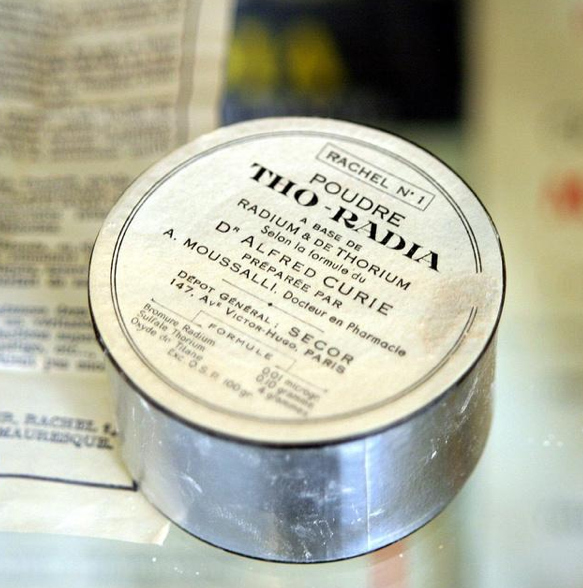
Dr Curie started something big. Cosmetics companies continue to claim they have the secret to eternal youth.
Like to see some more classic ads?
Have a look at 12 great vintage politically incorrect ads for Christmas gifts.
Read More
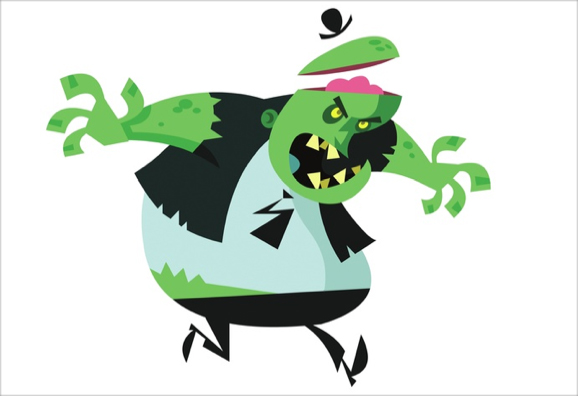
Everyone knows the way to lose weight is to eat less and exercise more.
Yet year after year most Australians are getting fatter. Fatter people aren’t as healthy. Fatter people die earlier than fitter, leaner people.
A whole industry makes money out of fat. Fitness clubs. Personal trainers. And diets. None of it works over time. The stats prove it. It’s not enough to know you have a problem. Personally I have never been better educated, yet I’ve never been so overweight.
Science has shown only cognitive behavioural therapy ensures long-term positive change and a healthier longer life as an ex-fatty. 21 days of mind reprogramming is just the start to breaking the usual fatso habits.
Business as usual doesn’t work. How long till the business you work for dies?
Australian businesses are fat. They aren’t fit enough to cope with today’s rapid pace of change and increasingly complex issues. They don’t exercise their brainpower by trying something new. And like most of us with a weight issue they are looking for the quick fix. So they outsource it.
The diet industry equivalent in this instance are the service providers, from the Deloitte pre-prepared meal programs and the peddlers of management boot camps, to the efficiency fitness trainers selling the benefits of Sigma 6 and Lean. Even the language is the same as The Biggest Loser.
The answer for struggling businesses isn’t in doing the same things more often, or paying more personal trainers to lift your motivation. Nor is it enough to reduce the excess fat by cutting costs. Stomach stapling the business results in staff suffering reflux, hunger pains and mental stress for no performance improvement.
The answer is cognitive behavioural change.
The answer is developing an innovation mindset.
Here’s how it works and why most businesses are doomed to die early.
It starts with the owners of the business recognising they have a problem. An attitude problem. Their brains have been thinking the same way so long their synapses have turned a well-worn groove into a rut of superhighway proportions. The problem is, it’s now a road to nowhere.
The new business opportunities aren’t where the brain has become accustomed to drive to, every category is seeing their marketplace become a ghost town. Today’s marketplace is somewhere new, and management not only don’t know where it is they don’t have a map to show them how to get there.
The new destination is growing, profitable and exciting. It’s enabled by the Internet and feeds on new ideas made possible by software as a service, unified comms and the cloud. The new place isn’t a city or a country or a category, it’s everywhere and anywhere the customer happens to be, 24/7. Now every customer or prospect can pick and choose what they want via a mobile device. From cat food to cars, retirement plans to restaurants, you can research and purchase without talking to a salesperson.
Yet business owners continue to think the value of their business is existing fixed assets and legacy systems, current supply contracts and distribution arrangements, proprietary processes and procurement systems. Australian managers continue to tweak a little here and there around the edges of their business models. Generally, the bigger the organisation the more cholesterol blocked the arteries of internal management and external communication.
Figuratively speaking, fat dead men walking the corridors of offices around the country are about to be knocked off by fit and nimble female and new age male entrepreneurial thinkers who are open source and open minded.
So what do our business leaders do? They buy another diet book, like the biography of Steve Jobs. What they don’t realise is reading about Apple is as relevant to middle managers as middle aged men reading about Usain Bolt’s exercise regime. Apple was a challenger brand from day one. It was in the DNA.
The answer isn’t reading a book on what someone else has done. It comes from doing what hasn’t been done. It comes from the confidence to try something new with a willingness to fail. Accepting you’re likely to fail again and again. Because continuing to do what you do now is guaranteed to fail. While with every new thing you try your chances of discovering a winner increases.
Changing your habits and practicing to do what doesn’t come naturally, every day, is the proven method for success. It’s making a habit of taking small risks often so you don’t stand still and become another Kodak. The proof is in understanding how Fujifilm could innovate itself a future as a cosmetics company.
Memories might be priceless, they just don’t make money like they used to.

How a traditional business became a challenger brand
Fifteen years ago Kodak entered a death spiral, from a global peak in 2000, camera film sales dropped 90 per cent in 10 years as the digital revolution swept the world. “We’d known it was coming since the 1980s,” says Yojiro Yamashita, general manager of Fujifilm’s life science products division.
Kodak didn’t make it, going bankrupt last year. Fujifilm not only survived but emerged into the digital world of today with a series of innovative new businesses.
Fuji recognised what its’ true strengths were says Tomoyuki Yamazumi, a cosmetics industry analyst for the research firm Fuji-Keizai. “It had the financial power plus a strong marketing ability and existing ties to consumers.” One of the small risks Fuji management took was launching a cosmetics range in 2007. By 2010, sales of Fuji’s upmarket Astalift brand were already over $100million a year. By 2018 the company is looking to increase skincare and supplement sales by ten times that.
Look around your business. Are you a Kodak, or can you recognise your strengths, try something new and innovate your way to a future as a challenger brand?
This article first appeared in AdNews, 30/5/13
Read More

At CeBit 2013, Salesforce Vice President Vivek Kundra’s big question for Australian leaders is “how can a country of 22 million people compete in a world of seven billion?” His answer?
“It’s not about size. It’s going to be about innovation. Innovation policy and an innovation agenda have to bethe come building blocks of a nation that’s going to compete in the global economy.”
Third wave of computing is changing the global economy
Competition in the global world of business is being driven by a ‘third wave of computing’. Essentially the shift from hardware to cloud based software and services and super fast mobile broadband networks that allow consumers and workers to access data on portable devices. Our clients have seen a doubling of visits to their websites from mobile devices over the last year. In fact, this year more people globally will access the Internet from a mobile than a computer.
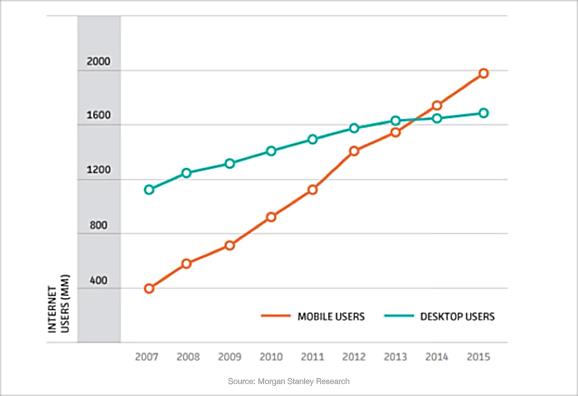
The opportunity for challenger brands
The biggest risk for businesses I’ve observed are the internal stakeholders defending their hard fought for legacy systems and infrastructure, and managers who are obsessed with efficiency through fine-tuning traditional methods. As Kundra points out, competitiveness now comes from letting go of what you’ve currently got now. “Most large scale organisations are still stuck in 1980s technologies. If you’re still stuck in an old mindset then unfortunately there’s a young entrepreneur who is imagining the way the world should be rather than it is.”
“The most amazing opportunities lie in reinventing entire sectors of the economy.” Vivek used the usual examples of US companies like Amazon, Netflix and Uber as businesses that are challenging categories today.
If you are running a business you have a clear choice he says – “do you want to be Amazon or Barnes & Noble?” This isn’t a particularly new view, as a global survey by Boston consulting summed up a couple of years ago, in this world of rapid change the spoils go to the nimble. Still, many managers still don’t seem to be responding.
“There’s a Darwinian spirit to the extinction of those who are holding onto the 1960s ways of doing business.” Vivek states, “not because it’s in the interest of the customer but because it’s easy and it’s because that’s what they know what to do.”
A marketer’s mantra for today: “The customer. The customer. The customer”
This is the biggest differentiator for challenger brands. “Companies that are embracing the third wave of doing business are doing it in the interest of the customer.”
Kundra recognises the fear of change within businesses when he suggests the best way to introduce a change culture is to build a prototype. “I think for too many people the expectations for transformative technologies is that it takes too long, costs too much and they’ve been burned in the past.”
A test and learn approach reduces risk
Last week at the launch of an AGSM Mid-Market program a professor specialising in innovation for business pointed out success today comes from having a portfolio of new initiatives that can be tested quickly in the marketplace. Rather than over researching only one strategy in an attempt to minimise risk, be willing to fail and fail frequently. The chances of some prototypes being winners with the customer will increase the more you try.
As Kundra says, aim to “be relevant and simplify the customers’ or citizens’ lives”.
Read More

The latest statistics on online fashion retail sales, research on the main purchase driver for financial advice and a Californian think tank pricing model all give marketers strong reasons to reconsider Price as a useful tool.
Evidence 1: Online fashion sales prove price not the motivator
No wonder Australian retailers are scared of online stores. British online retailer ASOS recently revealed that Australia is its single largest foreign market — with Australians buying something from the ASOS website every 6 seconds. The latest research from Roy Morgan shows at December 2012, 7.6% of Aussies aged 14+ (or 1,430,000 people) had made an online fashion purchase in any given four weeks — up from 5.7% (1,062,000) one year earlier.
Online fashion-purchasing habits by Australian women by sub-category, 2011-2012
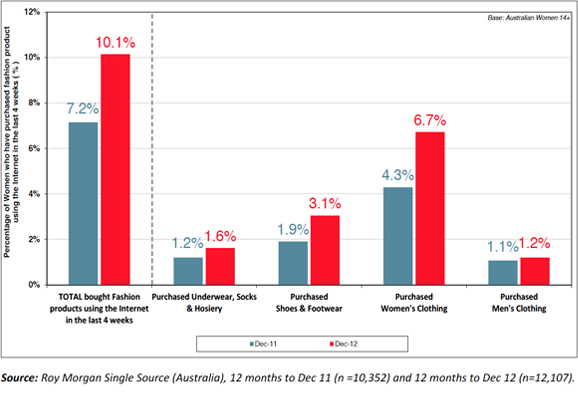
What is really interesting is the opportunities for marketers this research reveals. Most people would probably jump to the conclusion that these online sales are being lost by Australian stores because clothes are available cheaper from overseas. Everything on the web is cheaper, right? Well actually, no.
Roy Morgan’s research has found “scoring a bargain is not the main motivation for women purchasing fashion products online. Far more important is quality, with 75% of them agreeing with the statement ‘I believe quality is more important than price’.”
Discretionary spending by women on clothes has parallels with the way men seek financial advice. A recent national survey by an independent network of financial advisors found the vast majority of customers were more concerned about the quality of service and the frequency of face-to-face time they received than the size of the fee. Of hundreds of customers surveyed, price was rarely mentioned. Value was the primary concern, and the value equation was grounded in the perception of the quality of advice. .
None of this is new. I’ve been segmenting customers using the New Economic Order for nearly two decades since it was first developed by two Australian academics.
Evidence 2: choose who you want to be your customer
You can segment the population by three distinct sets which allow marketers to predict discretionary spending behaviour. The biggest segment, the Traditionals, sre generally cash poor with most of their spending accounted for with essential services, utilities bills, rent, transport and food. They have neither the capacity nor the predisposition to purchase discretionary items.
The other half has a common mindset, they share a desire to buy quality goods and experiences. This group is divided in half by their capacity to spend, one half are NEOs, and while they are only a quarter of the population they represent half all discretionary spending. Transitionals are NEOs on a limited budget: a career couple with one at home with a baby, or a high achiever that's just started their own business, or perhaps they have retired.
For 50% of consumers, the Traditionals, a cheap price is their opening and closing consideration. However these are the people who don’t spend much. They also deliver no sense of loyalty and don’t refer new customers. Every sale to a Traditional is a new sale that starts from scratch. And risks going to the lowest priced competitor on the day.
Most restaurant and airline customers and B2B purchasers are NEOs. These people research purchase decisions on the basis of what they believe are the features and benefits that mean the most to them. Price comes LAST, and isn’t much of a deal breaker.
Those latest stats on online fashion sales make sense in light of NEO behaviour. NEOs are online researching what’s hot in the world of fashion. In fact, it’s where they do most research when considering any major purchase because it’s where they control the levers, avoiding the unsavoury hassle of being sold by a salesman face to face. While Traditionals continue to spend the majority of their clothing budget on essential items like socks and undies in stores when the sales are on, NEOs continue to buy more discretionary fashion items, more often, both from the Internet and instore.
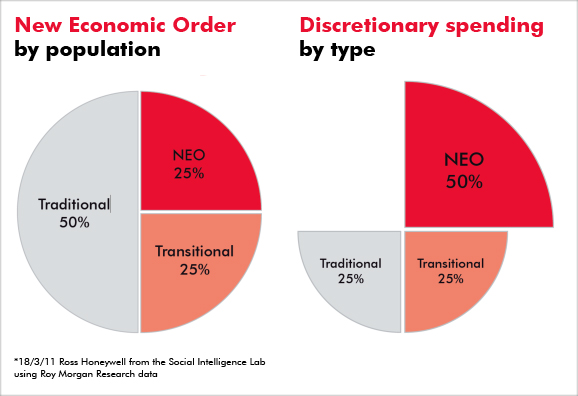
So what’s the best marketing model for selling to NEOs?
Evidence 3: all value is subjective
According to Ron Baker, the founder of Californian think tank the VeraSage Institute there are two fundamental approaches to pricing:
Cost-Plus Pricing
Labour Theory of Value
Product » Cost » Price » Value » Customers
Pricing On Purpose
Subjective Theory of Value
Customers » Value » Price » Cost » Product
You can see how subjective value pricing turns the order of cost-plus pricing on its head, by starting with the ultimate arbiter of value – the customer. In Baker’s words: “Goods and services do not magically become more valuable as they move through the factory and have costs allocated to them by cost accountants. The costs do not determine the price, let alone the value. It is precisely the opposite; that is, the price determines the costs that can be profitably invested in to make a product desirable for the customer, at an acceptable profit for the seller.”
As a marketer, for decades I found software one of the simplest products to approach from the Pricing On Purpose model; it’s the only reason Microsoft had education, standard and professional versions. The mid range product best reflects a fair margin for the cost of production of the product. The same product is then also sold at a low entry price with a few features turned off to maximise sales volume at the low end and repackaged in a fancy big box with a few extra features to maximise margin at the upper end of the market.
Choose who you want your customer to be, only then pick a marketing P
Whether you are selling clothes or cars, fair trade coffee or boutique wine, building materials or investment services, remember when your sales force wants you to discount, ask them to stop and think about the customer. Are you selling a basic product to a student, an authentic experience to a Transitional or a professional service to a NEO? Agree with sales who your customers are before you decide to use the PRICE lever.
Depending on who your customer is, Product, Place or Promotion may be more valuable to them than Price.
Read More

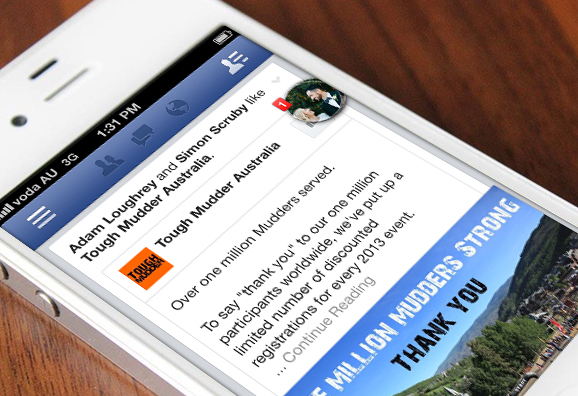
Just being active on Facebook isn’t enough. As with any communications medium, there are smart ways to achieve more for less effort.
Don’t be baffled by social media marketing spin doctors. Sure, Facebook has it’s own set of best practices. Hopefully by getting to know what matters and what doesn’t you can ensure any supplier will make the most of your investment.
The key to making the most of Facebook for your business is understanding it’s all about making sure everything you do improves your chances of being seen.
Much of this isn’t about paying for black art, it’s about basic step by step craft.
40% of time on Facebook is spent on news feeds
Only 12% is spent on profile or brand pages. So:
- Post articles on other people’s pagesPost on less pages more often
- Choose pages with high numbers of fansPhotos have higher ranking than links or text
- Use images
- Keep your text posts short – between 100 to 250 characters get 60% more engagement
- Ask a question
- Post daily and frequently
- Post about relevant topics – don’t push the brand
- Test your audience for their engagement times – 18-24 year olds are most active 9pm – 10pm, women 25-45 even later
How edge-ranking works is the key for marketers
All of these individual steps are only important because of something called edge-ranking. This makes or breaks social media marketing. This infographic shows how it works.
Read MoreThe health checklist for your sales process

15 questions to help your business determine the focus for your sales activity.
Do you have a sales department? Here are 15 questions to help change your sales force from sales takers to sales makers:
- How much time are you investing in new business a day?
- Is the total revenue and the sum of your clients’ budgets growing more slowly than in the past?
- Will growth levels come from present client budgets?
- Where will growth come from?
More frequency of purchase
More volume of each sale
More value? Up sell/or cross sell? - Will growth have to come from new business won from competitors?
- How do you sell to prospective clients?
- What’s your process?
- How do you find them?
- How do you win them?
- How do you prioritise sales calls?
- How is a sales call pre-qualified, (telesales/email/CRM)
- How long is spent face to face?
- What is your conversion rate?
- Is the sales call to the final decision maker?
- Who is the primary decision maker, how are they managed?
ROI marketing can help improve the performance of any of these sales metrics.
Marketing can speed sales, pre-qualify and build loyalty once you’ve made a sale.
In the past business owners were frustrated by an inability to measure what worked and what didn’t. Today there are tools and technques to enable you to measure the return on your marketing investment.
Read MoreTen biggest threats to business

A global survey has given us a picture of what exactly the biggest challenges are for business managers today. Across categories and regions the message is the same – there are half a dozen particular issues companies are feeling pressured by, but don’t know how to deal with.
Those clever marketers at Ernst & Young have come up with a catchy way of showing what we’re all facing – they call it the Risk Heat Map.

Businesses of every size are facing the same big problems. Fortunately current research shows how your business can turn this time of rapid change to your advantage.
The real insight for business owners in this picture is that while managers recognise these risks, as we look across the Y axis we realise most don’t know how to deal with them. These challenges are the consequence of a new paradigm. There’s an elephant in the boardroom – it’s right there in the middle, emerging technologies. Yes, it’s the Internet.
Drivers of business change
The Internet has changed everything. For the first time in the history of commerce, we now have true globalisation thanks to the transparency the Internet gives customers. People can now find the truth about any product or service in just a few clicks, in the privacy of their home or using a smart phone on the shop floor.
In the recent past there was still an advantage in being big – a manufacturer could configure a product and control its availability by region, a retailer could price a product depending on the suburb. Today with instant transparency, a customer can pick and choose from what’s on offer anywhere in the world.
Brands can no longer rely on any competitive advantage from tradition, size or resources. Rather, as Boston Consulting says – “in a world of change, the spoils go to the nimble”. The key to success is not just recognising the drivers of change, it’s ACTING on them.
The biggest risk to any business today is inaction. UNO has a proven formula for growing challenger brands. We can help you start today, risk free.
Email gm@unomarcomms.com for an outline of our process.
Read MoreWhat is beauty in commercial art?

“We have a duty to keep ads beautiful” said Craig Davis, co-chairman and chief creative officer with Publicis Mojo Australia and New Zealand in Campaign Asia, yesterday.
I respect Craig, we pitched against each other for The Rocks account decades ago when we were young and radical and creative directors of competing boutique Sydney agencies. I won. The next year I pitched against him again, for Sydney Water. He won.
Personally I don’t think advertising is art. It’s Commercial art, capital C. The latest CEO survey published in the same magazine reports 80% of the region’s CEOs think marketing people “are in La-La Land”.
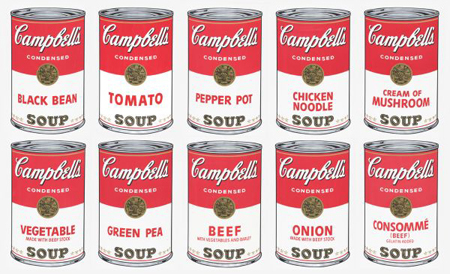
Craig’s musings on beauty in advertising aren’t going to change those perceptions. He is concerned “talent, craft and significance of ideas are being pushed aside by the desire to save time and money.” Craig makes a point worth taking the time to consider – we have all seen examples of the office junior being asked to whip up an ad because they know how to use clip art and can have it done in no time. Or the manager’s nephew is good with computers so he can build the corporate website for less.
All of this is being driven by the changes enabled by the Internet, “the flip side of the new digital meritocracy is that there’s an inordinate amount of noise generated” observes Craig.
He reminds admen “clients pay us to deliver results.” Hear, hear I say.
Then he returns to his point that “at its best, advertising is beautiful, but in the absence of creativity, it is just pollution. In the words of John Keats: Beauty is truth, truth beauty—that is all ye know on earth, and all ye need to know.”
Advertising that works is advertising that delivers a ROI
Business owners are more inclined to see beauty in numbers, like low cost per lead, and high rates of conversion. The fine balance of marketing communications is understanding how to use creativity to commercial advantage.
There is undeniable beauty in identifying a genuine human truth and expressing it to an audience in a way they find appealing. But let’s not talk about beauty for its own sake, lets talk about craft. Both in the craft of storytelling and execution, for business sake.
A century ago Dadaists like Marcel Duchamp challenged the protectors of traditional painting with the question “What is art?”
Before you invest in advertising, social media marketing or any program to grow your business, ask yourself, is this commercial art for the 21st Century? Is the execution well enough crafted to connect with your audience and leave the desired impression? Most importantly, will it give you the best return on investment?
It’s a commercial decision after all, not a beauty contest, don’t you think?
Why CEOs like Facebook yet fear it

The 2012 IBM global CEO study is just out. It once again confirms management is often aware of what needs to change, yet fear acting on their knowledge.
"CEOs need social media, but many fear it" – IBM
The world’s CEOs believe that in the next five years social media will push past websites, call centres and channel partners to become the No. 2 way to engage customers (after face-to-face communications).
However fear of change is preventing most from actually actioning a Facebook strategy. Many will miss capitalising on this inevitable trend to more agile competitors. Some fears are justified, there is no doubt there is risk involved with social media. Risk isn’t just bad ideas like CommBank’s terrorist Olympics viral video.
Advertisers are now liable for users' Facebook comments

Australia's digital industry is up in arms about a ruling from the ad watchdog, which determined a brand's Facebook page is an ad platform with all its material - including user-generated content - liable under the AANA code.
A recent ruling from the Advertising Standards Bureau (ASB) in a complaint against Diageo said it considered Facebook to be a marketing communication tool. The decision changes the landscape of social media advertising with brands liable for content generated by consumers.
In its ruling, the ASB wrote: “The Board considered that the Facebook site of an advertiser is a marketing communication tool over which the advertiser has a reasonable degree of control and could be considered to draw the attention of a segment of the public to a product in a manner calculated to promote or oppose directly or indirectly that product."
Social media advertising regulations and marketing your business
“The Code applies to the content generated by the advertisers as well as material or comments posted by users or friends.”
This is yet another example of how our regulatory frameworks are anachronistic in the era of the Internet. This new world of social media is merely a decade old, yet regulators like ASB are employing codes written in the steam age when ads were only mass distributed by printing press. Publishers had control of what letters to the editor were published with an eye on libel. But the pace of public postings on Facebook makes such a process for an editor of a business Facebook page less that of a publisher, more one of the town crier who invites people to the town square but can’t predict what the crowd will yell about loudest.
Right now the judiciary has similarly lacked an ability to adapt as the public circumvents contempt of court rules and out accused on Facebook, passing collective judgement before a trial. No blurred pictures of the accused’s face like in the press or on TV. Think the Kings Cross king hitter, perhaps fuelled by Diageo products. Lets see a post on a liquor brand’s Facebook about the next alcohol induced murder and ponder the consequences. It's going to happen, irrespective of what the ASB stipulates.
So if CEOs are going to increasingly use Facebook for a dialogue with prospects, we will need to be extremely diligent to keep on the right side of the law, irrespective of how sensible we think regulations are today.
Learn from Darrell Lea's Rocky Road

Darrell Lea's new Perth concept store opened in March. Too late to keep the administrators from the door?
Most business leaders know the 4 Ps from marketing 101. As Darrell Lea’s predicament shows, in today’s marketplace where change is underway at an increasingly blistering pace, keeping those easily understood basics working in your favour is becoming increasingly difficult. Here they are one by one:
Product
Mega trends like multiculturalism, gourmetisation of food products, better for you choices, and social issues like fair trade today shape what we choose to eat.
In the past it was enough to make minor adjustments to products and expect a sales lift simply by placing a NEW IMPROVED flash on the wrapping. For the last couple of decades there’s been little in the way of product innovation at Darrel Lea. As well intentioned as they may have been, small line extensions like fruit flavoured liquorice haven’t been enough to stop the sales decline.
Businesses have to be wary of who they entrust to give them independent counsel. Darrell Lea invested in research that resulted in a new tag line, “85 years of creating sweet magic”. One can argue this simply reinforced a backward looking management mindset.
Today customers are rewarding brave leaps forward in categories. As Max Brenner’s website proclaims, “Chocolate is not just about taste” it’s also about fashion. From Mexican spicy chocolate and hot chocolate shots to chocolate soufflés and Tiramisu, Australians are spending more money on chocolate than ever before as brands can come up with new adventurous ways to tempt them.

Challenger brands aren’t just new companies doing new things, old companies doing things differently are also being rewarded. Australia’s oldest chocolate maker/retailer, 97 year old family business Haigh’s has kept customers coming back and continues to entice new ones with adventurous new takes on chocolates.
Promotion
Cutting back on advertising for a short term cost saving is proven to come at a long term significant loss. Once a significant investor in advertising, Darrell Lea has been absent from mass media marketing for several years. It takes many years to build a brand and nanoseconds to damage one in social media. It pays to treat advertising as a compounding investment that pays an annuity in return.
Price
Too often price is only mentioned in the same sentence as promotion. It is in fact a two way lever. A 4 for $15 offer on Rocklea Road isn’t going to entice a new customer, it simply reduces the margin on a sale to an existing one.

Whereas Lindt, once considered a niche special occasion brand, has grown by offering a variety of chocolate balls across a range of pricepoints and product sizes that still maintain a premium.
Place
The Internet is making everyone reconsider where is the best place to make a sale? Ecommerce may not be right for a product that will melt in the mail, but is owning a shop the best alternative? Why own 63 shops when most chocolate sales are through Coles and Woolworths and convenience stores?
If you are going to have a retail outlet, it needs to have a good reason to justify the high overheads. Darrell Lea’s average over the counter sale is around $11 per customer. You’d need a lot of footfall to justify the rental on the King and George Street Sydney store. On the opposite corners are the eye candy Apple store and Louis Vuitton, where the products cost thousands (and are never discounted).
Challenger brands understand stores are the new 3D interactive ad medium. They are all about theatre and entertainment. Max Brenner has the theatre of their liquid chocolate Willy Wonka-esque stores.
Other retailers realise the store is simply the best way to gather new customers details for database driven online sales. The objective of the shop front is to entice prospects in and the brief to staff is to start a long-term relationship. For instance, banks lose money on physical branches, but haven’t found a better way to gain new customers. Citibank’s new branches in Hong Kong have been designed by the same architects as the Apple Stores. You can’t make a deposit at one of these new gleaming white banks with couches and interactive screens, you can have an espresso made by a barrista who is briefed to cross sell financial products to you.
How to stay competitive
Many market leaders are vulnerable to the threat that comes from failing to re-look at their entire business models. Simply reviewing the 4 Ps from the perspective of traditional wisdom will no longer ensure a business stays competitive. Market leaders that fail to embrace change, not just across product and service but entire systems and relationships, are increasingly less profitable than smaller challenger brands. There are a number of proven tools and techniques to help businesses rapidly adapt and trial new ways, feel free to ask us about some of them.
Boston Consulting has formally identified what savvy marketers know is the driver of business growth today:
In a world of change, the spoils go to the nimble*
*Martin Reeves and Mike Deimler, Boston Consulting Group,
Harvard Business Review July-August 2011

Founded in Adelaide by Alfred E Haigh in 1915, Australia’s oldest family-owned chocolate maker/retailer has a history of embracing change.
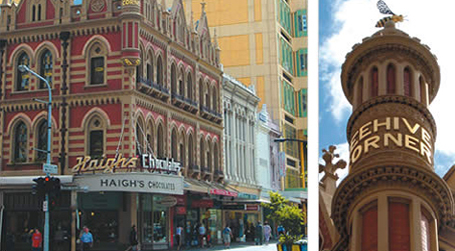
In the 1950s grandson John learned from Swiss masters Lindt and Sprungli and introduced European fine chocolate making to Australians. The current fourth generation Haigh family management preside over a business that represents barely 1% of Australia’s chocolate sales. Yet I would venture to say they are very profitable.
By continuing to innovate Haigh's continues to prosper as a challenger brand
Their award-winning Australian Collection was launched in 2003, with six native food centres including quandong, macadamia nut and honey, lemon myrtle and wattle seed. And as Australian’s have become more sophisticated in food tastes, Haigh’s have kept up with such adventurous chocolates as a South Australian truffle duet made with premium wines from the State’s wine regions.
Haigh’s environmental policies and sponsorships are just one indicator of how in touch this old business is with today’s consumer.
Last August at the Family Business Australia Conference, Joint Managing Director Alister Haigh told me they were ready for the next big change - online sales. The only sticking point is developing a delivery method that can guarantee the integrity of their heat sensitive product.
Following the biggest fine in UK finance history, it’s timely to look again at Barclays’ Big Ad

Barclays agreed to pay a record $442 million fine for rigging the London interbank offered rate last month. The scandal has cost the jobs of Barclays CEO Robert Diamond (below), Chairman Marcus Agius, and Chief Operating Officer Jerry Del Missier.
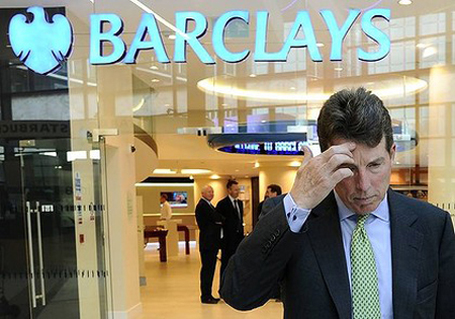
It pays to consider the future consequences of a single-minded marketing tagline. For Barclays, “We’re Big” just doesn’t cut it anymore.
If you're a marketer, Read This Or Die...

A friend sent me a YouTube link via Facebook – a comedy sketch by Bill Hicks, where the comedian asks anyone in the audience that’s in advertising or marketing to “kill yourself".
I was reminded of my profession’s tenuous grip on social acceptance when this week leading researchers Roy Morgan released their latest annual survey of how Australians rate the professions: ad people are still near the bottom, just above car salesman.
There is still hope for Admen and marketers – it’s about having conversations at the board level that explain in understandable terms how we can add value. This week McKinsey Quarterly published a checklist of 5 things that will help business managers get the best ROI from their marketing.
So for those who rate the wisdom of McKinsey's consultants, here in my words are the 5 tips that will make any CEO take you seriously.
1. What exactly influences our consumers today?
Mass media marketing to the masses is oh so yesterday. Thanks to the Internet, shoppers now consider options at more times in more ways, from reading online reviews to comparing prices when in-store using their mobiles. Once someone has bought something, they potentially become a reviewer themselves.
So how do you get into the new consumer's head? You can use anything from traditional research to online polls or social media tracking to get a better understanding of what consumers are now thinking about a category. The key is to be open minded about what you learn and have a management team willing to let go of accepted wisdoms.
2. How well informed (really) is our marketing judgment?
It was only a decade ago when traditional advertising was all that mattered. Marketers who new their stuff could make decisions safe in the knowledge what always worked in the past probably would tomorrow. And planned accordingly. Today you have to be able to recognise signals of change, and act on them. This means managers have to move out of their comfort zones and hypothesise, test new ways, then measure, analyse and adapt. Again and again. In McKinsey’s words there has always been a a need to define a “clear relationship between marketing spending and business results”. Today it has shifted from “should we be spending on marketing at all?” to “what’s the optimum marketing spending needed to hit our targets?”
3. How are we managing financial risk in our marketing plans?
Successful marketing communication takes hitting the right audience with the right message at the right time. The difference today is the targets are increasingly individuals and they are moving faster than ever. Traditional mass media allows advertisers to minimise risk by using metrics based on years of surveys that measure frequency and impact of a particular medium. Not so now. With today’s new media “influence can shift rapidly, and there is little accumulated experience about which messages work, when marketers should apply them, how they can be scaled, or even whom they influence”.
Measurement and risk reduction today comes from a closer relationship between sales and marketing and the channel. One of our clients has found scan data has new meaning now it can be overlaid with pre and post campaign brand tracking and the incredible analytics available using Shopperpedia.
4. How are we coping with added complexity in the marketing
organisation?
If you think it’s hard to keep up now, it’s only going to get harder faster. McKinsey's unsurprisingly suggest “you’ll require a number of specialists. You can’t get the skills and knowledge you need in just one person, and you’re not likely to get everything you need internally”.
5. What metrics should we track given our (imperfect) options?
At this point McKinsey goes into a whole grab bag of consultant speak. At UNO we think it best to get back to business basics – success should be measured by profit, not volume of sales or market rank. A business is successful when it can compete on more things than just price. And it knows it’s a real challenger brand when staff and partners are aligned and customers are referrers.
Now if you’re in advertising or marketing and you can’t get your head around the idea you have to change to survive, take a couple of minutes to laugh out loud as Bill Hicks encourages you to kill yourself
Where the smart budgets are being spent...Social Media
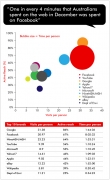
Have you noticed over the last decade that just about anything that isn’t nailed down has been digitised. Today we can access nearly everything from anywhere on anything – from getting the news on a tablet, trading shares on a mobile or accessing software services from the cloud. Plumbers are relatively safe, but most other businesses have to change.
The difficulty for business managers though is not just deciding how to make the change to digital, but how to make money out of it...
Pew Research Centre in the United States found that digitisation is burning money
Newspapers lost $10 in print ad revenue last year for every $1 they gained online. Just five companies, none of which existed a couple of decades ago are now taking 68% of online ad revenue: Google, Microsoft, Yahoo, AOL and Facebook.
Marketers know that they need to integrate traditional mediums with digital. Few businesses actually do – and some still think online is primarily for brands with young customers.
Businesses may be surprised to discover that the place where Australians spend the most time online, is also the most popular with women 25-45 years old.

The papers continue to spend money on journalists and creating the content, while these new companies continue to grow their revenue off the papers’ labours. Now because of their growing databases, fuelled by an understanding of people’s behaviour and preferences gathered from social media use, the digital intermediaries can now target ads more precisely than the old publishers.
The things we can now do on Facebook are incredible. In the past only advertisers who could afford to buy expensive data and research could precisely target their consumers. Now any advertiser can pretty well plan as effectively as the global giants by tapping into the growing wealth of intelligence of the social media technologists.
The Pew report says: “Two trends in the last year overlap and reinforce the sense that the gap between the news and technology industries is widening. First, the explosion of new mobile platforms and social media channels represents another layer of technology with which news organisations must keep pace. Second, in the last year a small number of technology giants began rapidly moving to consolidate their power by becoming makers of 'everything' in our digital lives. Google, Amazon, Facebook, Apple and a few others are manoeuvring to make the hardware people use, the operating systems that run those devices, the browsers on which people navigate, the e-mail services on which they communicate, the social networks on which they share and the web platforms on which they shop and play. And all of this will provide these companies with detailed personal data about each consumer.”
Business journalist Leon Gettler points out “Newspaper groups like Fairfax are the canaries in the coal mine for other industries facing similar challenges, from book shops and publishing to health care, industries where barriers to entry are low and where information is the main product. The trend to digitisation will accelerate with 'Generation C', people born from 1990 on who expect to be constantly connected through every possible device now entering the workforce, and with costs of computing and technology equipment dropping.”
“In every organisation, from media to retailers like David Jones, Myer and Harvey Norman, the biggest challenge always comes down to the tension between those who advocate a more aggressive approach and those aligned with legacy traditions, those who want to go fast and those who want to slow down.”
Adaptability: the new competitive advantage
As the pace of change accelerates, adaptability becomes the new competitive advantage. Long established leaders like Kodak, Borders and Fletcher Jones are a lesson in what management can expect if they don’t change their business model to integrate digitised marketing with their traditional methods.
Sources: Leon Gettler, Business Spectator, 28/3/12
Pew Research Centre, How Newspapers Are Faring Trying to Build Digital Revenue, 5/3/12
Why are marketers using Smartphones today?

The answer is in the numbers, and is a pointer to the next big thing.
Google researched 300,000 people around the world to find out their Smartphone use. Now as Australian marketers we can compare and contrast markets.
Number 2 for Smartphones in the world
Australia is now ahead of the US, UK, and Japan.
Average Smartphone under 12 months
Most of Australia’s Smartphones were purchased in the last 12months. We’ve gone from the back of the pack to the second highest penetration of this technology in the last year. Every month 1-2% of the entire population of Australia buys a Smartphone.
81% do it at home
More Australians used their Smartphones at home during the past 7 days than out – just 66% use them on the go.
50% like to watch
Almost 1 in 2 use their Smartphone while watching TV, while 1 in 3 use Smartphones and another Internet-enabled device at the same time. Talk about adult ADHD media consumption.
Smartphones are good for business
49% use their Smartphone to research and then call businesses – and 45% visit a business they’ve found using their Smartphone.
Aussies are obsessed with real estate
The stats confirm what we’ve all known from dinner party conversations – 1 in 5 Australians surveyed had looked for an apartment or house with their Smartphone – that’s 33% higher than the US or UK.
40% search daily
2 in 5 of Australian Smartphone owners use mobile search daily, that’s more than the UK or Germany and almost as high as the number who use desktop search daily.
The number of queries about retailers made via mobile devices has jumped 220 per cent year on year, and is now about 25 per cent of all queries.*
App, app and away
Australian survey respondents had 25 apps on average per Smartphone, Vs 23 in the US & UK. We’re not just talking free apps; Australians averaged 8 paid apps per phone.
TV or not TV?…
1 in 5 Aussie Smartphone owners would rather give up their TV than their Smartphone.
Better than sex?
1 in 3 say so according to a Telenav survey, that’s how many would choose their Smartphone rather than sex.

Now you’re up to speed with the omnipresence of mobile you’ll need to start thinking about how you can extend your online activity beyond a website that is viewed on a PC.
But wait, there’s more. Nothing stands still nowadays; to keep up you also need to be thinking of how to stay ahead of the competition.
So what’s next?
In just a year Australians have learnt to surf the web, send emails and watch movies on a Smartphone. Now consumers are moving to tablets because they are more convenient than laptops and obviously have a bigger screen than Smartphones.
1.2 million this year
In 2011 tablets will outsell Smartphones in Australia. 64 million tablets will be sold worldwide by the end of this year. #
73% of them will be iPads
Apple will sell 47 million iPads this year.#
We believe video to mobile devices is a game changing opportunity for challenger brands. Until now many marketers have been held back by the high cost of entry of mass media advertising. The amount of media consumption online has risen from 25 per cent in 2007 to about 42 per cent now. A new buzzword for marketers in the US is ''SoLoMo'' – as in social media, local networks and mobile. Savvy marketers are recognising the need to develop strategies that make the most of these new, powerful mediums. *
We believe you can now punch above your weight more effectively than ever by integrating video and content to create a genuine one-to-one dialogue on customers’ mobile devices. You’ll be surprised what is now possible…
50% conversion rate
50 per cent of people who inquired about a hotel via a mobile device went on to make a booking within a couple of days, compared with 20 per cent for those online via a computer. *
Give me a call on my Smartphone, 0412 982 538, if you’d like to know more.
*Ross McDonald, Google, 9/12/11
#Gartner, 8/12/11
"Greenwashing" Why a great idea that isn't true is a bad idea


What a shame this great ad for Steggles wasn’t for a producer of real free-range eggs. It was pulled because it’s a lie, even though beautifully told. Every person in every agency should be stegglers for detail.
The public deserves better than marketers passing off intensively “farmed” produce as free range when there isn’t room for the animal to scratch itself. “Greenwashing” takes many forms, like adding the claim Hormone Free to chicken packs when it’s been illegal to add hormones to any farmed chicken in this country since 1968.
At the moment here at UNO we are working on a campaign for an Australian innovation, the first plastic to biodegrade in modern landfill, which is where a billion disposable coffee cups end up each year across our country. We have told our client he can succeed as a challenger brand by telling the truth. There will be no green washing, just the facts about what this product can and can’t do. And we’ll do that the way all ad people should, with creative wit and human insight.
J Walter Thompson’s words of over 100 years ago are as right today as ever – “The truth, well told” is why we get up in the morning.
See the vodcast about what makes biorene biodegradable – the Earth eats it up!




Scan the QR code for our contact details.
Download the Neoreader app.
© COPYRIGHT 2013 UNO marcomms Privacy